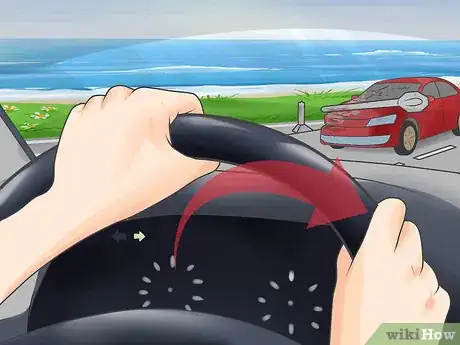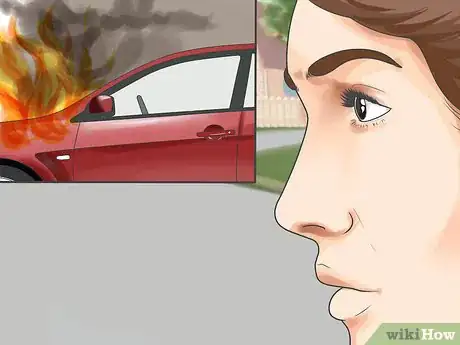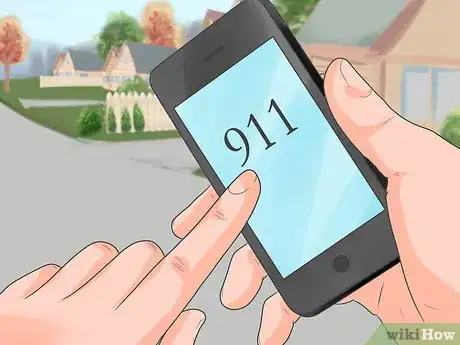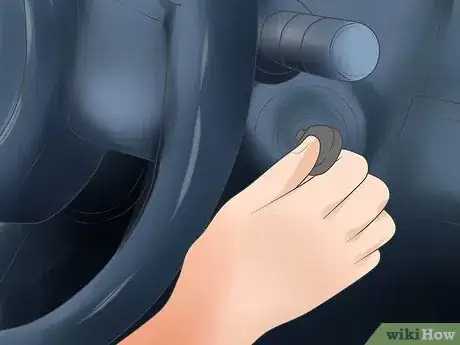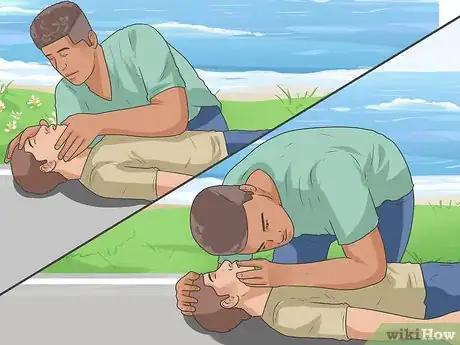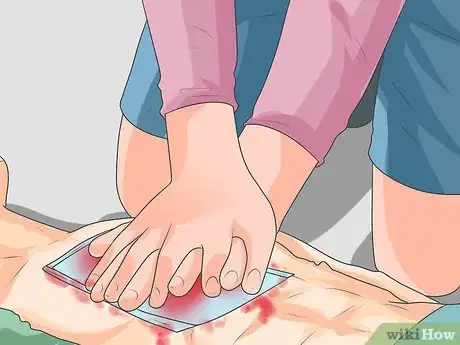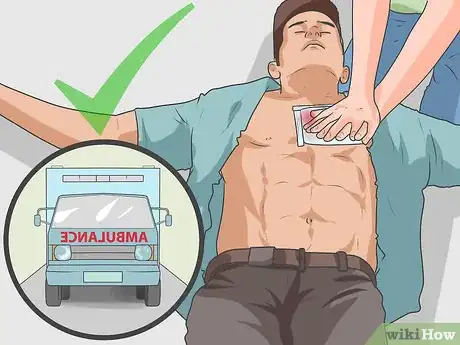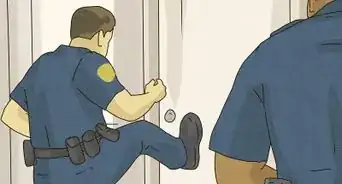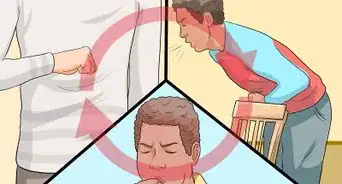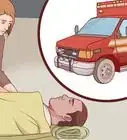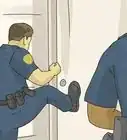This article was co-authored by Anthony Stark, EMR. Anthony Stark is a certified EMR (Emergency Medical Responder) in British Columbia, Canada. With over 11 years of experience, he has worked as an industrial medic and provided urban and rural paramedic services. He currently works for Mountain View Safety Services and previously worked for the British Columbia Ambulance Service. Anthony has a Bachelor of Engineering in Electrical, Electronics, and Communications Engineering from the Georgia Institute of Technology. He has completed the EMP Canada EMT Course and Swiftwater Awareness Training associated with the British Columbia Ambulance Service.
There are 8 references cited in this article, which can be found at the bottom of the page.
This article has been viewed 168,162 times.
Every year, anywhere from 20-50 million people across the globe are hurt, injured, or involved in car accidents. Because accidents are so common, you may witness one and have to help any victims. However, you might be unsure of the best way to provide aid on a road. By securing the scene and providing aid to any victims, you can help someone involved in a car accident.
Steps
Securing the Accident Scene
-
1Park your car to the side of the road. If you are the first responder to an accident or someone who can and/ or wants to provide assistance, pull your car to the side of the road. If the victim is in the road, use your car as a barrier. Make sure your car is safely out of traffic lanes and not blocking access to the scene or victim in any way.[1]
- Turn off your car’s ignition. Turn on your emergency flashers to alert other drivers that you are stopped. Remember that your emergency flashers will work even if your car isn’t running.
- Provide a barrier to victims in the road with your car and that of any other person on the scene. Make sure that barrier vehicles also have on four-way flashers to warn any oncoming vehicles.
-
2Remain calm. It’s important to you and any victims that you remain calm. This will help you make informed and rational decisions to best deal with the accident. If you feel yourself panicking in any way, take a deep breath to refocus or delegate tasks to others at the scene.[2]
- Avoid allowing any person panicking at the scene—be it a victim or bystander—to affect you. Staying calm and collected can prevent panic within the group as well as minimize any damage.[3]
Advertisement -
3Look over the scene quickly. Although your first instinct may be to call for help, taking a few seconds to quickly assess the situation can help you provide vital information to emergency services. In addition, it may also alert you to things that should be done before attending to victims.[4]
- Notice things like how many cars are involved, how many victims there are, if there is a fire, smell of gas, or smoke. You may also want to see if there are any downed live wires or broken glass.[5] You might also want to see if there are any children or pets and remove them to a safe location if they are not injured.[6]
- Make sure you are safe in the situation, too. You don’t want to be added to the list of casualties. For example, make sure there is no fire or smoke. If you are a smoker, put out your cigarette so that it doesn’t ignite any fluid draining from the car.
-
4Call emergency services. Once you’ve made a quick assessment of the accident scene, call emergency services. Provide the person with whom you are speaking any information request to the best of your knowledge. Ask other witnesses and bystanders to call emergency services as well. These people may have additional information or noticed something about the accident and victim you didn’t. Remember that the more information emergency services has, the better they can respond to an accident.[7]
- Give the operator information such as your location, the number of victims, and other details you noticed about the scene. Describe your specific location, including any landmarks, that can help responders find you. You’ll also want to tell the operator about any injuries that victims may have. Finally, let the dispatcher know if there are any traffic blockages that may hinder emergency services.[8] Ask the person any questions you may have about securing the scene or administering first aid.
- Be sure to stay on the line with the operator for as long as possible. This is true even if you have to momentarily put down the phone to secure the scene or help the victim.
-
5Warn oncoming traffic. It’s important to let other drivers know that there is an accident that they need to avoid. Using flagmen, which are bystanders who warn traffic, or flares can alert oncoming traffic to slow down. In turn, this may alert other drivers that they need to stop and assist with the scene and any victims.[9]
- Ignite flares if you have them and you are alone at the accident scene. If you don’t, make sure your emergency flashers are working. Set the flares a few hundred feet on either side of the accident. Only ignite flares if there is no fuel leaking anywhere.
- Tell other bystanders to alert oncoming traffic to slow down and avoid the accident scene. Make sure any flagmen stay out of the traffic lanes so that they don’t get injured. You may want to provide flagmen with reflective vests if available. Vests are a part of most car safety kits.
Providing Aid to Victims
-
1Check for danger. Before you can approach an accident victim, it’s important to make sure the scene is safe for you, too. Check to see if you see fuel flowing, fire, smoke, or exposed wires. If this is the case, you may be better not providing aid and simply calling emergency services.[10]
- If the accident victim does not immediately respond to your presence, check to see if all the doors are locked (generally a good thing). If this is the case, you may break the window that is farthest away from anyone in the car to offer further assistance.
- Turn off the ignition switch of any car involved in the accident if the scene is safe. This can further protect any victims and you.[11]
-
2Ask the victim about assistance. If the accident victim is conscious, ask if the person wants assistance. This is an important step because not every accident victim may want help, even if it appears the person needs it. By not respecting a victim’s wishes, you could be subject to legal action under Good Samaritan laws.[12]
- Ask the person “are you hurt and do you need assistance?” If the person responds yes, then provide the best aid you can. If the person says no, do not approach or provide aid to the person for any reason. Wait for professional help to arrive and let these people take over from there.
- Make the best assessment you can if the person rejects help and then loses consciousness. In these cases, Good Samaritan laws will protect you. Good Samaritan laws protect volunteers who provide aid or assistance in emergencies from legal liability for injuries or damages.[13]
- Remember to approach victims with caution even if they ask for assistance. The person could panic and hurt you, or something you do, such as moving the victim when you shouldn’t could hurt the victim even more.
- Check to see if a victim is conscious by lightly shaking the person. If the person doesn’t respond, she is unconscious.[14]
-
3Avoid moving the victim. Remember that many injuries are not visible on the skin. Unless the victim is in imminent danger from fire or something else, leave the person in place until emergency services arrive.[15]
- Make sure to approach a victim you have to move by kneeling down to the person’s level. Not doing so can send someone into a panic and may cause further injury.
- Remember that it’s better to move someone whose life is threatened by something like a possible explosion or fire than it is to leave them for fear of further injuring the victim. Consider the following phrase when making your decision “am I leaving the person better off than the way I found him?”[16]
-
4Check the airway. Breathing is an absolute necessity to any person’s life. If a person is unconscious or loses consciousness, it’s vital to check the victim’s airway to ensure the person is breathing properly. If not, you may need to give CPR to restart the circulatory and respiratory systems.[17]
- Place your hand lightly on the victim’s forehead and very gently tilt back the head. Lift up the chin with two fingers and put your cheek by the victim’s mouth to see and feel if the person is breathing. You may also want to check the victim’s chest to see if it is rising and falling. If so, then the victim is breathing.[18]
- Start CPR if the person is not breathing and you know how to perform it. If you do not know how to do CPR, do not attempt it. Instead, ask other bystanders if they are able or wait until emergency services arrives.
- Roll the victim on to the person’s side to protect the airway. Make sure to support the person’s neck to protect or prevent injury.[19]
- Make sure to let the emergency dispatcher know if the victim is breathing and/ or receiving CPR.
-
5Administer aid—as necessary. Many advocates suggest providing first aid only if the victim has life threatening injuries. If the victim has injuries that require bandaging, splinting broken bones, or using other advanced first-aid techniques, it’s generally recommend to wait for professional help, especially if you know it is on the way.[20]
- Keep the injured person as still as possible. Talking to a victim can go far in calming the person.[21]
- Pack clothing or bandages around the spine or broken bones to prevent movement.
- Stop any bleeding by applying direct pressure to the injury with bandages or clothing. Elevate the area bleeding to chest height if possible. If the victim is conscious, ask the person to apply pressure to help calm any shock.[22]
-
6Treat shock. It’s common for car accident victims to be in or fall into shock from the accident. Shock can be life-threatening if not treated, so if you notice the most common symptom of shock—pale skin—then treat the person for it.[23]
- Remember the phrase “if the face is pale, raise the tail.” A pale face is a good indicator of shock.
- Loosen any tight clothing and put blankets, coats, or clothing over the victim to keep the person warm. If you are able, raise up the victim’s legs. Even resting the victims legs on your knees can help prevent or minimize shock. You may also want to shade the victim from the sun or falling rain to minimize shock.[24]
-
7Comfort the victim. Chances are that the accident victim is scared and possibly hurt. Talking to and giving the victim encouraging words can help calm the person down until emergency services arrive.[25]
- Offering encouraging words to the victim. For example, you could say “I know you’re hurting, but you’re strong and help is on the way. I’m going to stay with you as long as you need me.”
- Hold the victim’s hand if you can. This can be a significant help for a person’s sense of survival.
-
8Turn over care to emergency personnel. Once emergency services arrive, let the personnel take over the person’s care. These individuals are better trained to handle car accidents and any injuries.
- Provide emergency services with any information they should know about care you’ve administered to the victim or other things you may have noticed. Ask if there is any way you can help them best do their job. In many cases, it will simply be speaking to the police when they arrive on the scene.
Warnings
- Move the victim to a safe spot only if you suspect the car will explode or catch on fire.⧼thumbs_response⧽
References
- ↑ http://www.roadandtravel.com/safetyandsecurity/accidentfirstonscene.htm
- ↑ http://www.survivetheride.org/riders/first-aid/
- ↑ http://www.atsdr.cdc.gov/emergency_response/common_misconceptions.pdf
- ↑ http://www.roadandtravel.com/safetyandsecurity/accidentfirstonscene.htm
- ↑ http://www.trafficaccidentadvice.co.uk/basic-first-aid-if-you-witness-car-accident.html
- ↑ http://smartdriving.co.uk/Driving/Driving_emergencies/accident.htm
- ↑ http://www.roadandtravel.com/safetyandsecurity/accidentfirstonscene.htm
- ↑ http://www.emergencymentors.com/report-a-car-accident-to-the-emergency-services/
- ↑ http://www.roadandtravel.com/safetyandsecurity/accidentfirstonscene.htm
- ↑ http://www.survivetheride.org/riders/first-aid/
- ↑ http://www.roadandtravel.com/safetyandsecurity/accidentfirstonscene.htm
- ↑ http://www.roadandtravel.com/safetyandsecurity/accidentfirstonscene.htm
- ↑ http://www.astho.org/Programs/Preparedness/Public-Health-Emergency-Law/Emergency-Volunteer-Toolkit/Volunteer-Protection-Acts-and-Good-Samaritan-Laws-Fact-Sheet/
- ↑ http://www.survivetheride.org/riders/first-aid/
- ↑ http://www.trafficaccidentadvice.co.uk/basic-first-aid-if-you-witness-car-accident.html
- ↑ http://www.roadandtravel.com/safetyandsecurity/accidentfirstonscene.htm
- ↑ http://www.roadandtravel.com/safetyandsecurity/accidentfirstonscene.htm
- ↑ http://www.trafficaccidentadvice.co.uk/basic-first-aid-if-you-witness-car-accident.html
- ↑ http://www.survivetheride.org/riders/first-aid/
- ↑ http://www.roadandtravel.com/safetyandsecurity/accidentfirstonscene.htm
- ↑ http://www.survivetheride.org/riders/first-aid/
- ↑ http://www.trafficaccidentadvice.co.uk/basic-first-aid-if-you-witness-car-accident.html
- ↑ http://www.trafficaccidentadvice.co.uk/basic-first-aid-if-you-witness-car-accident.html
- ↑ http://www.roadandtravel.com/safetyandsecurity/accidentfirstonscene.htm
- ↑ http://www.roadandtravel.com/safetyandsecurity/accidentfirstonscene.htm
About This Article
If you see a car accident, immediately call 911 and report the location and details of the crash. Only approach the scene if there is no fire, smoke, or gasoline. If the scene is safe, ask the victim “Do you need help?” before assisting. Then, if they say yes, help as best you can; if they say no, wait for help to arrive. Unless the accident victim is in immediate danger of a fire or explosion, avoid moving them in case they have internal injuries that could be further damaged. For more ways to help a car accident victim from our EMT reviewer, including administering CPR, keep reading!
